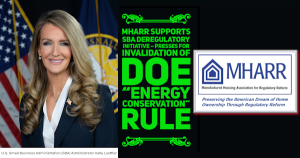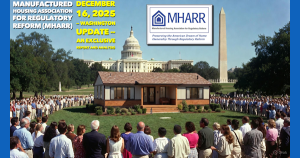Ms. Sofie Miller
U.S. Department of Energy
Room 6A-013
Office of Energy Efficiency and Renewable Energy
1000 Independence Avenue, S.W.
Washington, D.C. 20585
Re: Proposed Procedures for New or Revised Energy Conservation Standards and Test
Procedures for Consumer Products – EERE-2017-BT-STD-0062; RIN 1904-AD38
Dear Ms. Miller:
The following comments are submitted on behalf of the Manufactured Housing Association for Regulatory Reform (MHARR). MHARR is a Washington, D.C.-based national trade association representing the views and interests of producers of manufactured housing regulated by the U.S. Department of Housing and Urban Development (HUD) pursuant to the National Manufactured Housing Construction and Safety Standards Act of 1974 (42 U.S.C. 5401, etseq.) (1974 Act) as amended by the Manufactured Housing Improvement Act of 2000 (2000 Reform Law). MHARR was founded in 1985. Its members include independent manufactured housing producers from all regions of the United States.
On February 13, 2019, the U.S. Department of Energy (DOE) published a proposed rule in the Federal Register[1]that would significantly modify its procedures for developing new or revised energy conservation standards and related testing procedures for consumer products, “appliances,” and certain commercial and industrial equipment. Among other things, the February 13, 2019 proposed DOE procedural rule would: (1) expand various procedural protections to the development of testing standards for regulated products; (2) define “a significant energy savings threshold that must be met before DOE will update an energy conservation standard;” (3) address issues related to the cumulative regulatory burdens imposed on regulated products and consumers of those products; and (4) “clarify DOE’s commitment to publish a test procedure six months before a related standards [Notice of Proposed Rulemaking].”
While this proposed rule, as published, does not specificallyreference standards development and/or testing procedures under section 413 of the Energy Independence and Security Act of 2007 (42 U.S.C. 17071) (EISA), concerning energy conservation standards for federally-regulated manufactured homes, its procedural protections should nevertheless apply (as appropriate)[2]to the development and revision of DOE manufactured housing energy standards and related testing procedures under that provision, insofar as the proposed rule, by its express terms,doesapply to DOE’s Appliance Standards Program, and boththe previously-proposed June 17, 2016[3]DOE standards for such homes and the currently-pending proposed energy standards for manufactured homes, set forth in an August 3, 2018[4]DOE Notice of Data Availability (NODA), derive directlyfrom a “negotiated rulemaking” process conducted by and within the DOE Appliance Standards Program.[5]Given that the proposed and still pending DOE manufactured housing standards were developed under DOE Appliance Standards Program procedures that areaddressed by the changes proposed in the February 13, 2019 DOE Notice, the procedural modifications noted in that proposed rule shouldbe applied to the manufactured housing proceeding, including both any initial DOE manufactured housing energy standards and any subsequent modifications or updates to those standards. Thus, DOE should expressly provide in any final rule for the application of appropriate procedural protections to manufactured housing energy standards in the event that such standards remain under the jurisdiction of DOE and an element of – or within – the appliance standards program.
Moreover, the fact that such fundamental procedural protections – now deemed necessary and, indeed, essential by DOE itself – were notaccorded the industry and consumers in the DOE manufactured housing negotiated rulemaking and subsequent related proceedings, constitutes yet another basis (among many others previously detailed by MHARR) for the withdrawal of any and all previously-proposed versions of the DOE manufactured housing standards – developed under or derived from — the inherently tainted DOE “negotiated rulemaking” process, and the ultimate development of a new rule (if necessary) based on a legitimate and lawful standards-development process consistent with the regulatory policies of the Trump Administration.[6]The application of the new procedural rule to the manufactured housing energy rulemaking, could also help to assure that any future revisions of that rule are not subjected to the same type of coordination between part of the industry and energy special interests that led to the fatally-tainted and illegitimate “negotiated rulemaking” which resulted in both DOE’s original 2016 proposed manufactured housing energy standards rule and subsequent 2018 NODA proposal.
Accordingly, for all of the foregoing reasons, MHARR asks that DOE, in any final rule in this matter, expressly apply all pertinent procedural protections and safeguards, as set out in its February 13, 2019 proposed rule for the appliance standards program, to any manufactured housing energy conservation standards, revisions thereto, or any applicable testing procedures developed by DOE pursuant to EISA section 413.
Sincerely,
Mark Weiss
President and CEO
cc: Hon. Rick Perry
Hon. Ben Carson
Hon. Mick Mulvaney
[1]See, 84 Federal Register, No. 30, February 13, 2019, at p. 3910, etseq. The deadline for comments from interested parties concerning this proposed rule was subsequently extended to May 6, 2019, by notice published in the April 2, 2019 edition of the Federal Register. See, 84 Federal Register, No. 63, April 2, 2019, at p. 12527, etseq.
[2]Portions of the proposed procedural rule, such as provisions relating to American Society of Heating, Refrigeration and Air Conditioning Engineers (ASHRAE) reference standards, would obviously not apply to manufactured housing standards as defined by section 413 of EISA.
[3]See, 81 Federal Register, No. 117, June 17, 2016, at p. 39756, etseq.
[4]See, 83 Federal Register, No. 150, August 3, 2018 at p. 38073, etseq.
[5]See, NODA Packages, Draft Results, July 2018, at p. 2: “Incremental cost and savings calculations are based on methods and data presented in the 2016 NOPR” which, in turn, derived from the 2014-2015 DOE negotiated rulemaking process under the auspices of DOE’s Appliance Standards and Rulemaking Federal Advisory Committee (ASRAC). Seealso, 81 Federal Register, supra, at p. 39763, col. 3, noting that DOE applied the same “analytical framework” for manufactured housing standards “that DOE uses for developing energy efficiency standards for appliances.”
[6]Seee.g., (1) MHARR August 8, 2016 comments on “Energy Efficiency Standards for Manufactured Housing” (EERE-2009-BT-BC-0021; RIN 1904-AC11); (2) MHARR July 14, 2017 comments on “Reducing Regulation and Controlling Regulatory Costs Under Executive Orders 13771 and 13777 – Request for Information;” and (3) MHARR September 17, 2018 comments on “Energy Conservation Standards for Manufactured Housing Notice of Data Availability – Request for Information” (EERE-2009-BT-BC-0021; RIN 1904-AC11).













